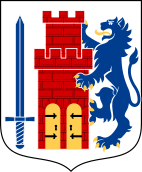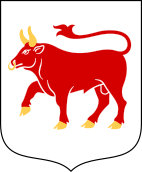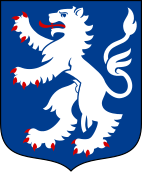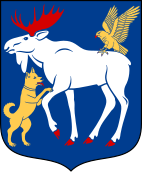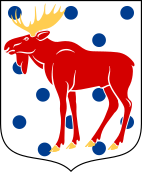Provinces of Sweden
This article needs additional citations for verification. (December 2007) |

The 25 provinces of Sweden (Swedish: Sveriges landskap) are historical, geographical and cultural regions. They have no administrative function, but retain their own cultural identities, dialects and folklore.
Several were administrative subdivisions until 1634, when they were replaced by the counties of Sweden (län). Some were conquered later on from Denmark–Norway. Others, like the provinces of Finland, have been lost.
In some cases, the county and province borders correspond almost exactly, as with
Nevertheless, the provinces of Sweden are no archaic concept; they are still referenced in everyday speech and seen as culturally distinct. The main exception is Lapland, where people see themselves as citizens of Västerbotten or Norrbotten, based on the counties.
Sweden's two largest cities, Stockholm and Gothenburg, both have provincial borders running through them: Stockholm is split between Uppland and Södermanland, and Gothenburg is split between Västergötland and Bohuslän. According to a 2011 survey, people in major cities – Stockholm, Gothenburg and, to a lesser extent, Malmö – identify primarily with their city, rather than their province.[2]
Provinces
| Swedish | Latin |
 |
|---|---|---|
| Ångermanland | Angermannia[3][4][a] | |
| Blekinge | Blekingia[3][b] | |
| Bohuslän | Bahusiana provincia[3][4] | |
| Dalarna | Dalecarlia[3][4][c] | |
| Dalsland | Dalia[3][4] | |
| Gästrikland | Gestricia[3][4] | |
| Gotland | Gotlandia[3][4][d] | |
| Halland | Hallandia[3][4][e] | |
| Hälsingland | Helsingia[3][4] | |
| Härjedalen | Herdalia[5][f] | |
| Jämtland | Iemtia[3][g] | |
| Lappland | Lapponia[3][4][h] | |
| Medelpad | Medelpadia[3][6] | |
| Närke | Nericia[3][4][i] | |
| Norrbotten | Botnia septentrionalis[3] | |
| Öland | Oelandia[3][4][j] | |
| Östergötland | Ostrogothia[3][4][k] | |
| Skåne | Scania[3][l] | |
| Småland | Smolandia[3] | |
| Södermanland | Sudermannia[3][m] | |
| Uppland | Uplandia[3][4] | |
| Värmland | Wermelandia provincia[4] | |
| Västerbotten | Westrobotnia[4][n] | |
| Västergötland | Westrogothia[4][o] | |
| Västmanland | Westmannia provincia[4] |
English and other languages occasionally use Latin names for Swedish provinces. The name Scania for Skåne is particularly common in English. Some English
History

The origins of the provincial divisions lay in the
After the separation from the
When Sweden ceded Finland to the Russian Empire in 1809, Västerbotten was divided up so that Norrbotten first emerged as a county. Eventually, it came to be recognized as its own province. It was granted a coat of arms as late as in 1995.[12]
Some scholars suggest that Sweden revived the concept of provinces in the 19th century.[13]
The lands of Sweden
Historically, Sweden was seen as containing four ”lands” (larger regions):
- Götaland (southern Sweden)
- Svealand (central Sweden)
- Österland (Finland, from the 13th century to 1809)
- Norrland (northern parts of present-day Sweden and north-western Finland)
In the
Due to the
The regional borders have changed several times throughout history with changing national borders. Norrland, Svealand and Götaland are only parts of Sweden, and have never superseded the concept of the provinces.
Heraldry

At the funeral of King
Some of these arms were short-lived, such as the beaver for Medelpad (changed in the 1570s),[12] the wolverine for Värmland (changed in 1567)[12] and the roses on Småland’s arms. Östergötland was represented by two different arms, one with a Västanstång dragon and one with a Östanstång lion. The current arms for Östergötland (see below) were created in 1884.[12]
The current arms for Småland were created for the coronation of John III in 1569. The wild man representing Lapland was created for the funeral of Charles IX in 1612.[12] Arms for Jämtland were created when Norway ceded the province to Sweden in 1635. Arms for Härjedalen were created later. The arms for Blekinge, Bohuslän, Halland and Skåne were created for the funeral of Charles X Gustav in 1660. The Arms for Norrbotten were created as late as 1995.[12]
At Erik XIV's coronation in 1561, a division of the provinces into 'duchies' (hertigdom) and 'counties' (grevskap) was introduced. However, this system never achieved lasting stability. In 1884, the King in Council gave all provinces the right of use to a ducal coronet for their coat of arms.[15][16][14] Some of the Finnish provinces, which were separated from Sweden in 1809, still feature a count's coronet.
Götaland
Götaland comprises ten provinces in the southern part of Sweden. Until 1645, Gotland and Halland were parts of Denmark. Also, until 1658 Blekinge and Scania were parts of Denmark, and Bohuslän was part of Norway. Värmland was counted as part of Götaland until 1812.
Svealand
Svealand comprises six provinces in central Sweden. Until 1812, Värmland was counted as part of Götaland instead.
Norrland
See also
Notes
- ^ also Angermania[4]
- ^ also Bleckingia provincia, Blechingia[4]
- ^ also Dalia[4]
- ^ also Godlandia, Gothia, Gothlandia, Guthia, Gutlandia[4]
- ^ also Halandia provincia[4]
- ^ also Herndalia, Harnedalia[4]
- ^ also Iemptia provincia, Jemtia[4]
- ^ also Lappa, Lappia, Loppia[4]
- ^ also Neringa[4]
- ^ also Olandia[4]
- ^ also Gothia orientalis[4]
- ^ also Schonia[7]
- ^ also Sudermannia provincia[4]
- ^ also Bothnia occidentalis[4]
- ^ also Gothia occidentalis, Westragothia[4]
References
- ^ "Folkmängd i landskapen den 31 december 2016" (in Swedish). Statistics Sweden. 21 March 2017. Archived from the original on 31 October 2022. Retrieved 17 April 2018.
- ^ GfK Sverige AB (21 December 2011). "Svenskarna är mer lokala än nationella i sin geografiska identitet". Archived from the original on 13 December 2021. Retrieved 13 December 2021.
- ^ ISBN 978-91-7227-572-0.
- ^ a b c d e f g h i j k l m n o p q r s t u v w x y z aa ab ac ad ae Graesse, Johann Georg Theodor; Benedict, Friedrich; Plechl, Helmut; Plechl, Sophie-Charlotte (1972). Orbis latinus : Lexikon lateinischer geographischer Namen des Mittelalters und der Neuzeit (in German) (full ed.). Braunschweig: Klinkhardt & Biermann.
- ^ "Orbis Latinus - Letter H". www.columbia.edu. Retrieved 26 April 2025.
- ^ "Orbis Latinus - Letter M". www.columbia.edu. Retrieved 26 April 2025.
- ^ "Orbis Latinus - Letter S". www.columbia.edu. Retrieved 26 April 2025.
- ^ Eric Linklater in The Life of Charles XII (1960)
- ^ Robert Nisbet Bain in Gustavus III and His Contemporaries (1894)
- ^ Bernard Quaritch in The stories of the Kings of Norway Called the Round World (Heimskringla) (1893)
- ISBN 978-1-59331-276-3.
- ^ ISBN 978-91-7886-092-0.
- ^ Jacobsson, Benny (2000). "Konstruktion av landskap. Exemplet Uppland" Archived 2 February 2009 at the Wayback Machine. Idéhistoriska perspektiv. Ed. Ingemar Nilsson, Arachne 16, Göteborg 2000, p. 109-119. Retrieved 20 October 2006. (In Swedish).
- ^ ISBN 978-91-976240-9-1.
- ISBN 978-91-7886-092-0.
- ^ Hildebrandt, Hans. "Landskapens vapen". Antiqvarisk/Antikvarisk tidskrift för Sverige / Nionde delen (in Swedish): 54–57.

